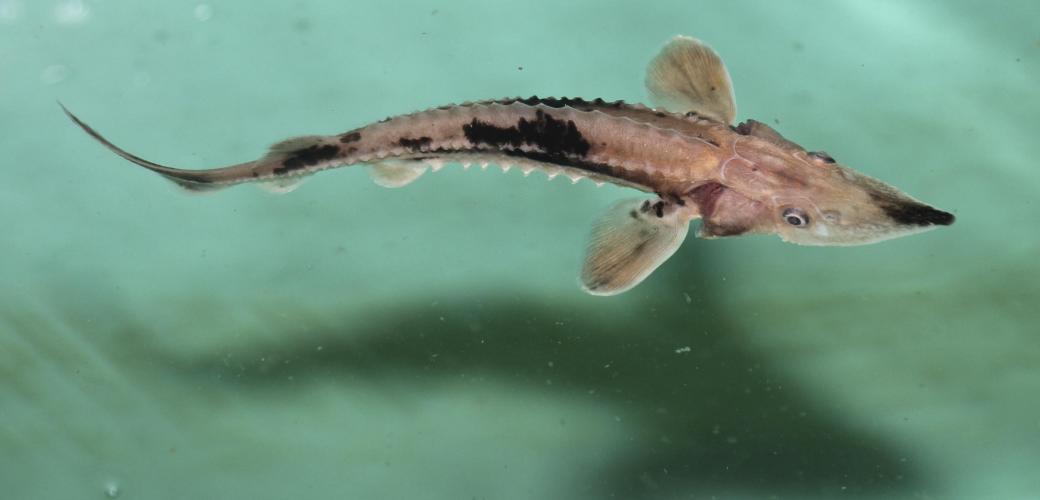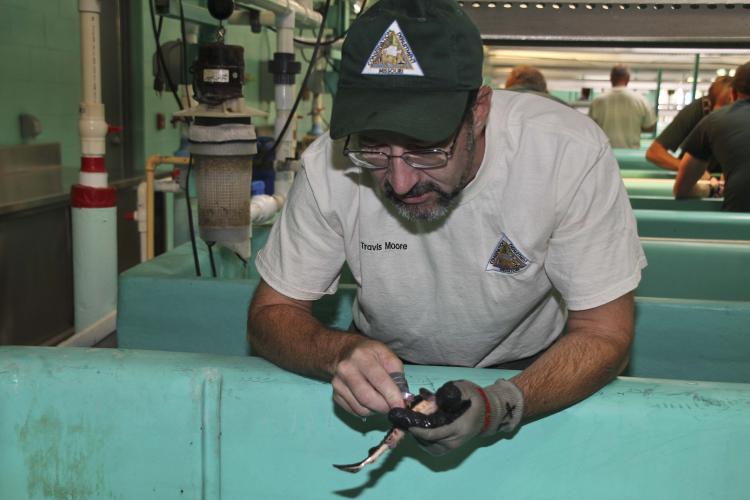
Xplor reconnects kids to nature and helps them find adventure in their own backyard. Free to residents of Missouri.


































Stay in Touch with MDC news, newsletters, events, and manage your subscription

Xplor reconnects kids to nature and helps them find adventure in their own backyard. Free to residents of Missouri.

A monthly publication about conservation in Missouri. Started in 1938, the printed magazine is free to residents of Missouri.




Warsaw, Mo. -- Travis Moore reached into a fish hatchery tank and with one hand picked up a young fish, one that in the next century might require three people to lift. The squirming, six-inch lake sturgeon he held is capable of growing into a giant that long outlives biologists trying to save the species’ future.
The biggest lake sturgeon can reach eight feet and 300 pounds. This year, biologists in a northern state measured an egg-producing female lake sturgeon that weighed 240 pounds and was more than seven feet long.
“They believe that it was 125 years old,” Moore said, “which means she was born sometime in the late 1800s.”
It’s remarkable that a fish that old is still reproducing, said Moore, a Missouri Department of Conservation (MDC) fisheries biologist who is leader of the Lake Sturgeon Recovery Team. The flip side is that it takes 25 or 30 years for a lake sturgeon to reach reproductive size and age, and they don’t always spawn every year. Slow reproduction is one reason why they are a state endangered species in Missouri.
Reversing that trend is why Moore and MDC fisheries crews handled 12,672 hatchery-raised lake sturgeon by hand on Sept. 25, one fish at a time. They marked them by removing a specific scute, a scale-like plate, from the fishes’ side. Each fish also received a tiny wire chip in its snout that is magnetized to carry information about its origin. The fish were released Sept. 27 into the Grand, Osage and Gasconade rivers, just upstream from where they empty into the Missouri River.
Years from now, the same fish may be caught by biologists conducting research. A missing scute will hint that the fish was stocked and not spawned in the wild, and which scute is missing will tell them what year the fish was stocked. A magnetic wand passed near the fish’s mouth will read the tag and provide more information. The fish will be weighed and measured, and biologists will have data about their travels in the rivers, habitat preferences, survival rate and growth rate.
Lake sturgeon date back 150 million years. The species swam near wading dinosaurs and out-survived those beasts. They require large waters and are native to the Missouri River, Mississippi River, Great Lakes and Hudson Bay ecosystems. Sturgeon use tube-like mouths on the undersides of their elongated heads to suck up small fish, snails and other food.
Overharvest by commercial fishing greatly reduced lake sturgeon numbers in the United States by the early 1900s. Continued loss of habitat due to human changes to rivers and lakes caused further declines.
But biologists are working to bring back Missouri’s largest fish.
MDC began releasing lake sturgeon into the state’s big waters in 1984. Research has shown that maturing lake sturgeon spend most of their time in the deep pools of the biggest rivers. But they often travel long distances between stops. Most lake sturgeon stocked by MDC were released in the Mississippi or lower Missouri River on the state’s eastern side. But MDC research crews have caught and measured lake sturgeon upstream in the Missouri River all the way to Iowa. Some have been caught in the Kansas City area and a few in the lower Kansas River.
Lake sturgeon are protected in Missouri and must be released if caught. Adults have rounder bodies, shorter snouts and smooth barbels that distinguish them from the far smaller and more common shovelnose sturgeon, or the endangered pallid sturgeon. Anglers fishing for catfish catch them at times.
The goal is to build self-reproducing lake sturgeon populations, Moore said.
“Someday down the line we might have a sport fishery with limited harvest,” he said. “When caught on a rod and reel they will actually tail walk like a largemouth bass.”
But it might take another 20 years of stocking, management and research for the fishery to grow enough in Missouri to take lake sturgeon off the state endangered list, Moore said. They are considered a good eating fish in states with populations large enough to allow harvest.
"These lake sturgeon will be the biggest fish in the state of Missouri someday,” he said. “There’s nothing else that reaches 200 pounds.”